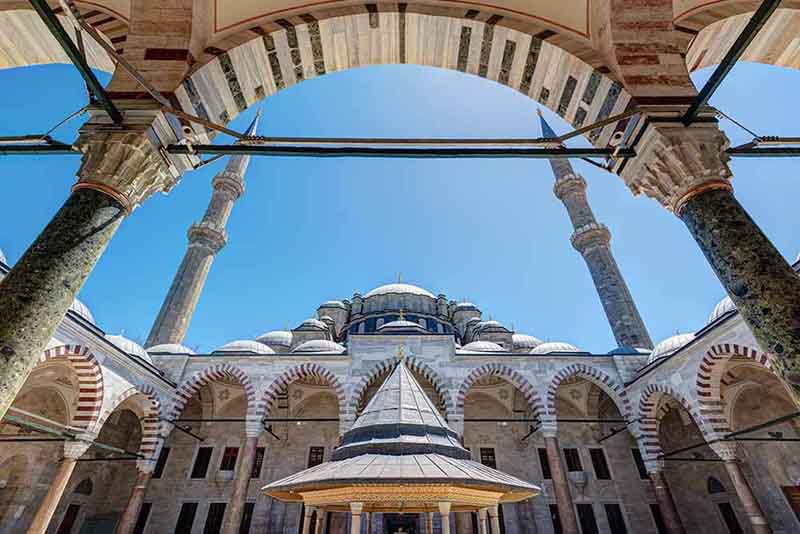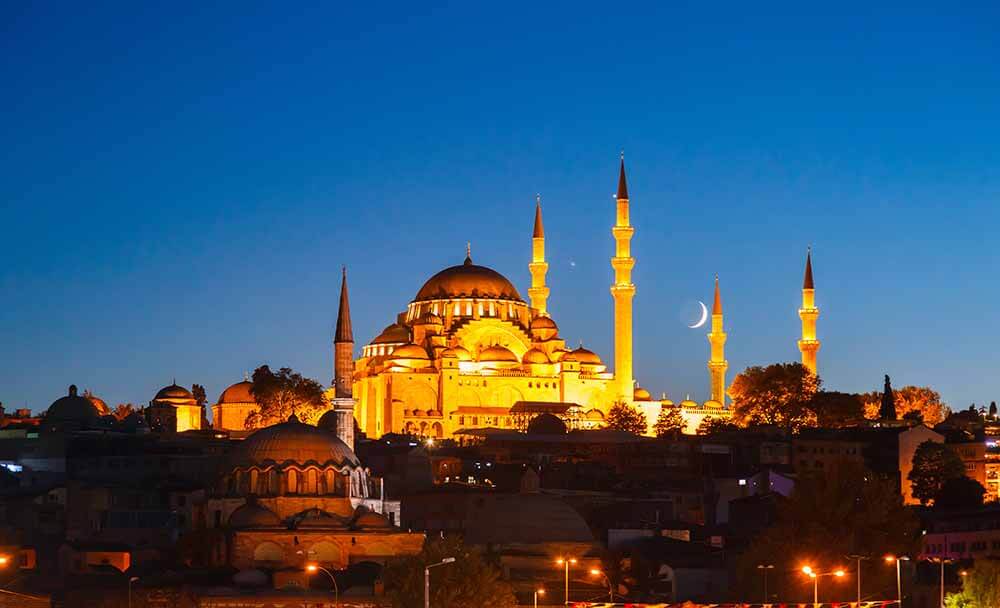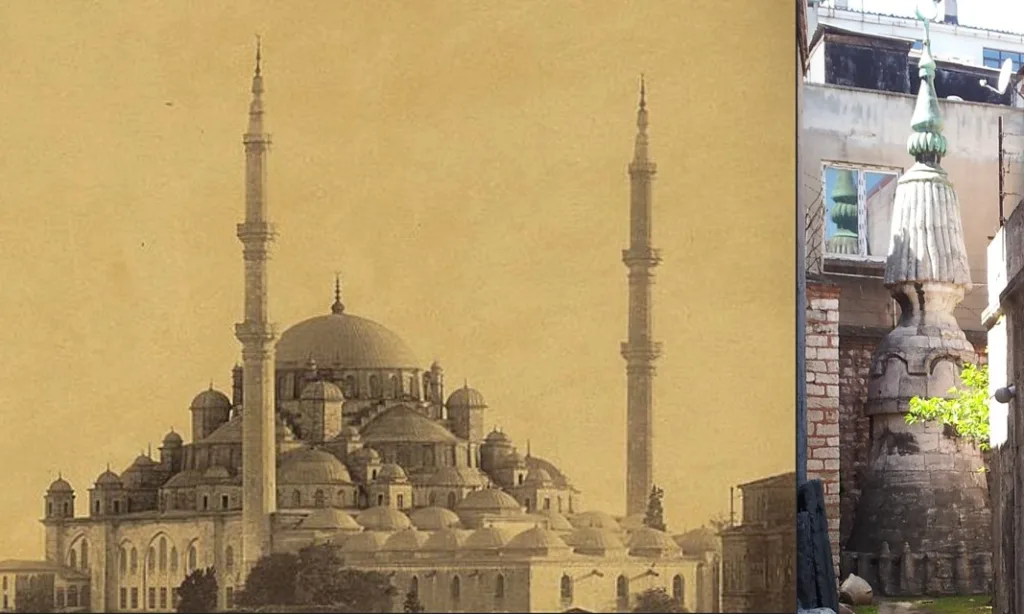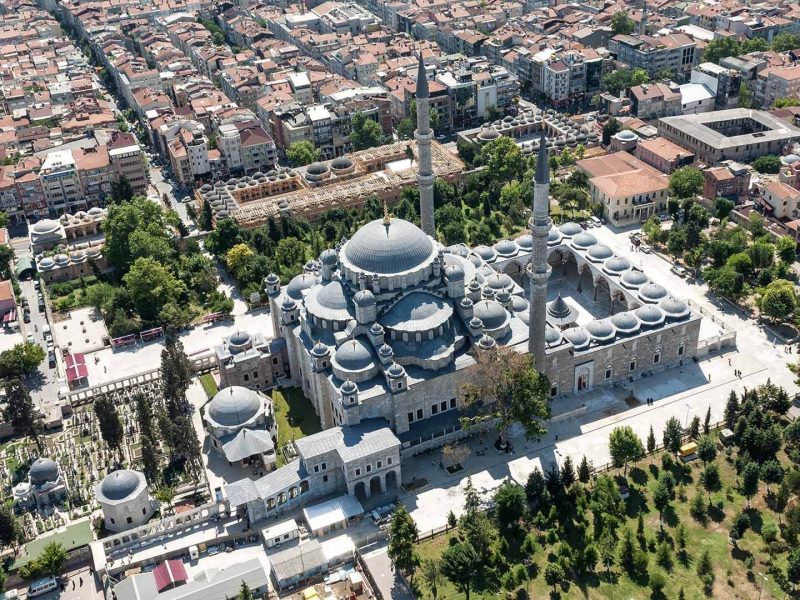Fatih, which is one of the districts where conservatism is most intense in Istanbul, embodies a different structure, which is shaped around Fatih Mosque. After the conquest of Istanbul, Fatih Sultan Mehmet, built the mosque on top of the remains of the Havariyyun Church (the Holy Apostles Church), considered highly sacred to Rome.
Havariyyun Church and 13 Coffins Underneath
In Islam, there are companions who help the Prophet, and in Christianity, there are volunteers called apostles who helped Jesus. The Havariyyun Church (the Holy Apostles Church) takes its name from these apostles.
Constantine, the founder of the Eastern Roman Empire, had the idea to build a monumental grave for himself while he was alive, so he planned the construction of his own mausoleum.

Aerial view of Fatih Mosque and Istanbul.
According to the belief, there were 12 apostles who helped Jesus. Constantine built coffins at the bottom of the church for those apostles. He then had one more coffin made for himself. In other words, Constantine regarded himself as the 13th apostle and wanted to continue his eternal rest in the same place where the bones of the other 12 apostles were kept.
Constantine passed away on May 22, 327 around İzmit. After he died, his son placed his remains in the mausoleum of the Holy Apostles Church, as was his wish. According to the custom, some of the bones of the 12 apostles were found in different places and buried in the coffins. A part of the sarcophagus in which Constantine is buried is exhibited today at the Istanbul Archaeology Museum.

The Fatih Mosque located in Fatih district, Istanbul, Turkey.
Restorations of the Havariyyun Church
A great earthquake shook Constantinople in 358 AD and the grave church built by Constantine in this earthquake was severely damaged. Immediately afterwards, another church with a cruciform plan was built next to the grave church, as approved by the ruler of the period. In 527 and 565 AD, Emperor Justinianus built this church, and a larger new church, also a basilica, was built. The newly built mausoleum contained tombs of the Roman Empire until the 11th century. Constantine 8th, who died in 1028, is the last emperor to be buried in the mausoleum.
The mausoleum was completely looted in 1204 during the Crusades, and many parts of it were destroyed in the 1296 earthquake.

Fatih Mosque or Conqueror’s Mosque in Istanbul, Turkey.
Construction of Fatih Mosque
The church, which was damaged after the 1296 earthquake, is not fully restored. It continues to serve as a religious place although many of its parts were ruined. After Fatih Sultan Mehmet conquered Istanbul in 1453, it continued to function as a patriarchate for a while. But later, when Christians requested that the Monastery of Pammakaristos be the patriarchate, the remains of the Havariyyun Church were completely destroyed by Fatih Sultan Mehmet in 1461. Fatih Mosque was built in its place.

Fatih Mosque in Istanbul
Architectural Properties of Fatih Mosque
The Fatih Mosque was built in place of the Havariyyun Church, which was considered sacred during the Roman Empire period, and became a center of attraction for the Muslim life in Istanbul. The mosque, which was in construction for seven years, has a dome built on two elephant feet and two columns. However, a great earthquake occurred in 1766 and the mosque was almost destroyed. Architect Mehmet Tahir Ağa under the order of Sultan Mustafa III rebuilt it. In this construction, the mosque structure with buttress was used, the number of elephant feet was increased to four and the domes were converted into four half-domes. Thus, a large mosque with a spacious interior was obtained, and it continues to exist today as one of the most important historic buildings of Istanbul, surrounded by its fountains and courtyards.

The minaret caps of Fatih Mosque were once made of stone. One of the stone caps from the 18th century fell onto the mosque courtyard at the end of the 1960s after being struck by lightning, piercing the courtyard pavement and breaking apart. As a result, the other stone cap was removed and placed in the garden of the Amcazade Hüseyin Pasha Madrasa in Saraçhane.

